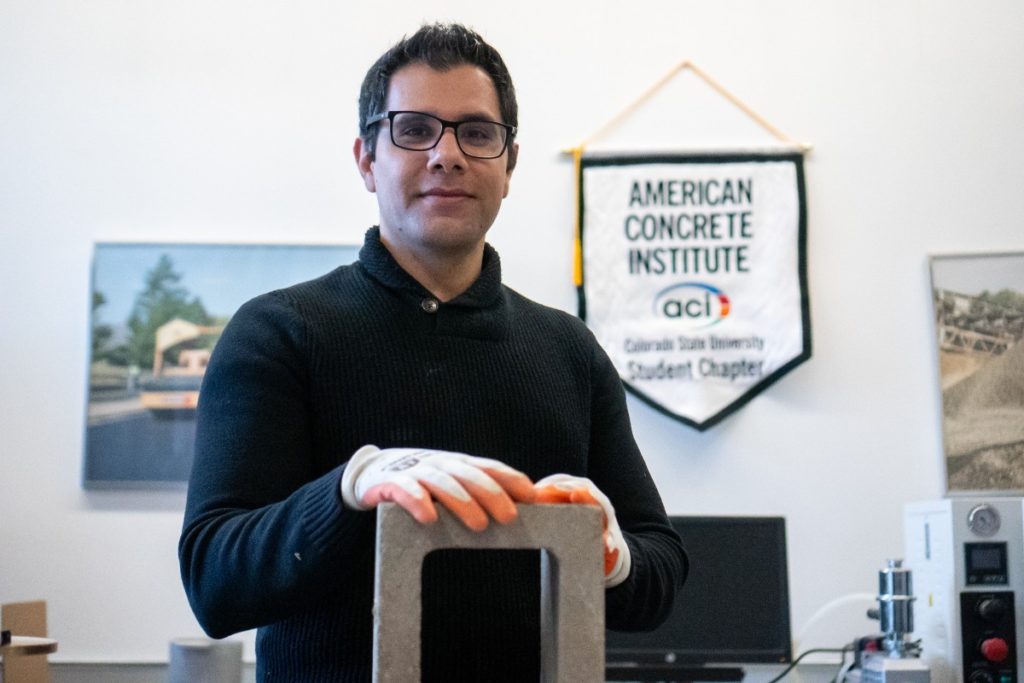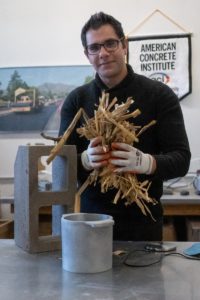
According to the USDA, more than 90 million acres are devoted to the production of corn in the U.S. The kernels may end up in the cornflakes on your breakfast table or used for animal feed, and the stalks and leaves can be used for animal feed or improving soil health. Now, another use for the crop residue may be on the horizon – making a common building material more environmentally friendly and durable.
Mahmoud Shakouri, assistant professor in the Department of Construction Management at Colorado State University, is investigating using ash made from raw corn stover—the term for the leaves, stalks, and cobs of corn plants—to replace some of the ingredients typically used to make concrete and building components.
Challenges of traditional concrete production

Because of its strength and durability, concrete is used extensively in the construction of roads and structures. However, as the second largest consumed material in the world, concrete production contributes a fair share to increased carbon dioxide (CO2) emissions and global warming.
Shakouri is looking specifically at concrete blocks, or “concrete masonry units (CMUs),” and examining corn stover as an alternative, bio-based material that requires less processing energy and releases less CO2 into the atmosphere, for replacing a portion of the cement in CMUs.
Other ingredients to make concrete can include compounds from iron and steel production, known as “slag,” as well as “fly ash,” which is a byproduct of burning coal in coal plants. Many of these ingredients are either in short supply or more expensive right now. And, as the energy sector shifts from coal dependence to more sustainable sources of energy, the supply will continue to decrease.
“One of the significant challenges facing the suppliers of cementitious materials is the shortage of fly ash, used extensively in road and pavement construction,” said Shakouri. “The shortage of supplementary cementitious materials provides a unique opportunity for emerging materials such as corn ash, which will be produced in this project. This ash has similar properties to fly ash and can be produced locally without compromising the environment.”
Improving the strength of concrete blocks

In a previous project funded by the Nebraska Research Initiative, Shakouri developed cementitious materials from raw corn stover. His preliminary results after testing the new concrete showed increased concrete strength and durability. For his new research, Shakouri will manufacture and test CMUs – 8”x8”x16” blocks which are commonly used in foundation walls to support framed construction, exposed interior and exterior walls for buildings, and freestanding landscape and retaining walls.
Beyond their environmental issues, conventional CMUs are known to crack and break easily under tension, a problem Shakouri hopes to address. His objectives include studying the chemical, physical, and mechanical properties of corn ash and fiber, and to investigate the roles they can play in improving the mechanical and durability properties of CMUs. He also will evaluate the performance of corn-based CMU blocks, including fire and thermal resistance.
Economic advantages of ‘CornCrete’

In addition to solving environmental and durability issues, “CornCrete” blocks might be the key to solving other problems as well. Shakouri is looking at the economic feasibility of production and the possibility of addressing building material shortages and supply chain issues.
The proposed technology will tap into crop residue and can create added value for some U.S. corn growers. In addition, Colorado passed a “Buy Clean Colorado” bill in 2021, requiring the Office of the State Architect and the Department of Transportation to establish policies that include the maximum global warming potential for specific categories of construction material, including concrete and cement, in all public projects.
“Colorado’s new bill will create significant demand for low-carbon building materials,” said Shakouri.
The recent boom in the construction industry has created a substantial material shortage for contractors. For example, according to a recent report by the U.S. Chamber of Commerce, 93% of commercial contractors face some material shortage, and the current supply chain is incapable of meeting the market demands. Such shortages have led to considerable delays and increases in the price of housing in most regions, especially in Northern Colorado. Shifting a key ingredient in building materials to a sustainable source may also reduce waste.
“This technology has the potential to create economic opportunities for the manufacturers and suppliers of construction materials in Colorado, as well as the corn growers,” said Shakouri.
The Department of Construction Management is part of CSU’s College of Health and Human Sciences.